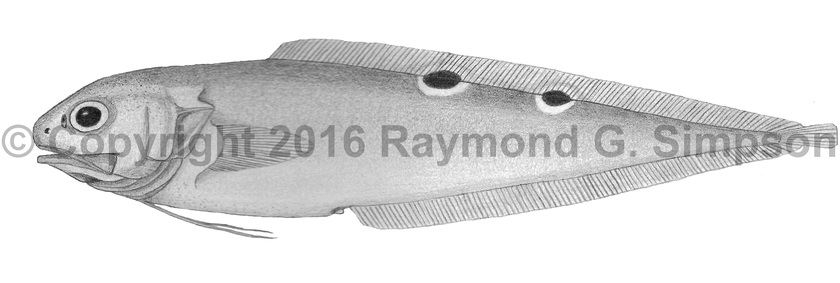
Common Name
Two-spot Brotula
Year Described
Goode & Bean, 1885
Identification
Dorsal Fin: 88-97
Anal Fin: 73-81
Pelvic Fin: 2
Pectoral Fin: 23-25
Caudal Fin: 8
Gill Rakers: 12-15 (only long rakers)
Pseudobranchial Filaments: 3-6
Vertebrae: 52-56
Body elongated and eel-like. Snout blunt. Jaw extends past posterior margin of orbit. Teeth present in jaws, on palatine, and on vomer. Anterior basibranchial tooth path narrows on posterior end. Preopercular spines number 0-1. Spine on preopercle weak but broad in small fish but absent in large specimens. Opercular spine strong. Dorsal and anal fins confluent with caudal fin. Pelvic fin reaches 2/3 of the way to the anus. Lateral line not obvious. Body scales cycloid.
Color
Body brown above, grading to whitish on the belly. There are tiny melanophores sprinkled on the ventral body and the head. Gill region, gut, lips, and area around anus darker brown. Dorsal fin usually with two ocelli (sometimes one; rarely 3-4). The two dominant ocelli are at midbody and one posterior to that. Smaller individuals can have more ocelli.
Size
Maximum size to 229mm SL
Habitat
Occurs on continental shelves from 59-229m. A relatively shallow living member of the genus.
Range
Restricted to the Gulf of Mexico where it occurs from off W. Florida to off Texas and the Bay of Campeche.
References
Nielsen, J. G. 1999. A review of the genus Neobythites (Pisces, Ophidiidae) in the Atlantic, with three new species. Bulletin of Marine Science v. 64 (no. 2): 335-372.
Nielsen, J. G., F. Uiblein and M. M. Mincarone 2009. Ocellus-bearing Neobythites species (Teleostei: Ophidiidae) from the West Atlantic with decription of a new species. Zootaxa No. 2228: 57-68.